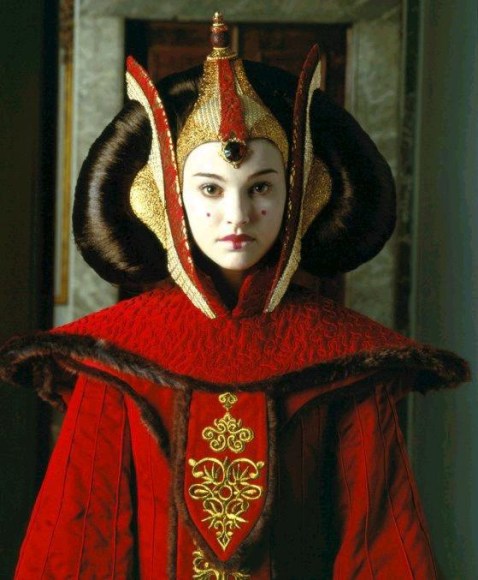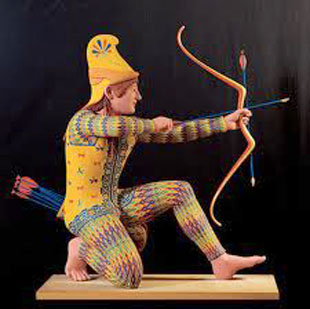
A generation of teenage boys seemed to feel that this was the height of feminine appeal. (Of course many of them probably did not have many opportunities for comparison.)
I’ve recently been browsing through various online resources for artists — how-to’s, advice about materials, online portfolios, etc. — and I’ve noticed something that disturbs me: When did “Learn How to Draw” come to mean “Learn How to Draw Natalie Portman in Star Wars Makeup”?
It’s odd, really. The drawings that these folks are so anxious to create, or to help others create, are nothing more than slavish reproductions of photographs, publicity shots that we’ve all seen a thousand times. Wouldn’t it be just as satisfying to simply print out the photo and pin that up somewhere? If I had just spent four hours drawing each and every little hair on Justin Bieber’s fluffy little head, I think I would want to keep that accomplishment to myself — in fact, I imagine I would go to some trouble to conceal it — not offer a step-by-step tutorial on YouTube.
Imitation is supposed to be the sincerest form of flattery, but what exactly is being imitated here? Rarely does anyone copy the photos of the stars from the cover of the National Enquirer. It’s always the intensely glamorized images, with perfect hair, perfect makeup, perfect lighting, that turn up again and again. It’s that perfection beyond reality that arouses such interest, not the real person whose flesh and bone provided the scaffolding that the image was built upon.
In times past a person who wanted to become an artist spent a considerable amount of time in museums, copying the great masters. Those gentlemen whose works hung in the Prado and the Louvre had answered all the questions, solved all the problems; your success as an artist was going to be measured by the extent to which your work duplicated theirs. Any deviation meant that you were wandering into territory that was not deemed appropriate for an respectable sculptor or painter — inappropriate expressly because these giants had not gone there first.
For centuries the great statues and architectural works of classical Greece were assumed to have been designed as we see them today: stark, white and austere. That “classical” purity was the model for everything that followed, from Roman emperors to the Lincoln Memorial: the substance of the stone itself was the only acceptable surface for such works.

We just assumed the ancient Greeks had a more subdued fashion sense. (Photo from Stiftung Archaeology)
Art historians have come to realize, however, that the ancient sculptors actually painted their statues in vivid colors: great public centers like the Parthenon and the Temple of Olympian Zeus were, by modern standards, garish, dizzying, rambunctious; the images were intended to appear, not as remote stone effigies, but as living, breathing beings, with skin the color of human skin, and clothing and jewelry in all the colors that the Greeks of the day admired and wore themselves.
What does this new information say about all those bare white statues decorating capitol rotundas and civic monuments and great museums all over the world? Perhaps it says less about the works themselves than it does about how we respond to — and use — a fashion, an ideal, a style. The stark whiteness of the Greek statues, as we imagined them, became a symbol of purity and strength that we imitated over and over in our own art and public expressions. Even now, knowing that the model we were emulating was a mistake, our attachment to that style is unchanged: we are not prepared to give up that “classical” look that bears such a freight of meaning for us. We don’t want our heroes to look too real, to be too human. We like depicting Abraham Lincoln fifteen feet tall and ghost-white from head to toe, because it makes him more impressive, more godlike; unlike the Greeks who built the temples of the Acropolis, we don’t want our deities to be too much like us, we don’t want them to have human foibles and weaknesses, and we don’t want them wearing red striped ties and blue socks.
Our unrealistic expectations reach far beyond appearances: we expect politicians to resist temptations to which a pop star is almost required to succumb on a weekly basis to sustain his “cred”. While a college professor who marries four times in four years is highly suspect, an actress who remains happily married for twenty-five is even more so. Human behavior, human excellence, human failings: all are viewed through a different prism when the individual being judged is larger than we are, more prominent, more visible, and the expectations are tailored not just to fame itself, but to the specific role that the famous individual is playing in our society.
Roman Emperor Julius Caesar divorced his wife Pompeia not because of any fault of her own, but because she had been the victim of a stalker, and the Emperor felt that the gossip attendant on the case was a political liability for him. Pompeia had committed no crime, but a love-sick young man had splashed color on the snowy whiteness of her public image, and this was just too much for her husband’s constituency to bear.
(Today, on the other hand, a female in the public eye who never suffers the attentions of a stalker is almost seen as deficient in some way, inadequate.)
We cleave to these idealized images of our leaders and thinkers, our stars and our heroes, because those are images of a perfection beyond our own ability to achieve. We need feel no responsibility to become more than we are, to strive for the same kind of stature, because our idols are so patently more than human; their achievements are so clearly beyond anything we can hope to emulate, that we can absolve ourselves of the need to do and be and become more than we already are.
We worship these pale, inhuman idols because they are inhuman, and therefore present no challenge to our complacency. We reject the garish gods of Greece because they are mirrors, and a mirror doesn’t show perfection, it only shows the truth.
* * *
Leave a Reply